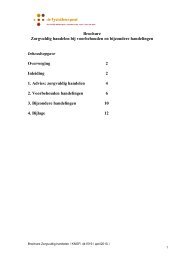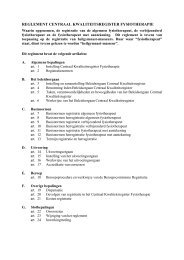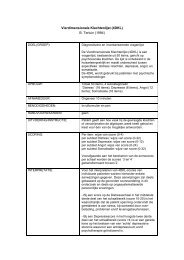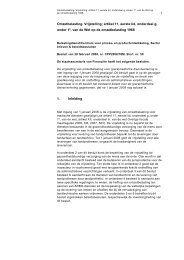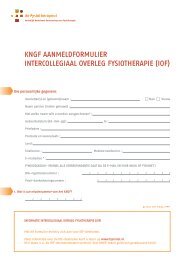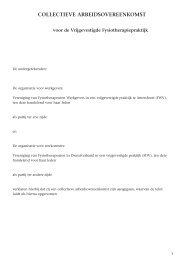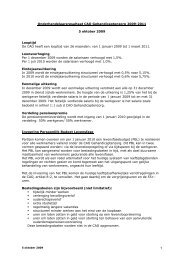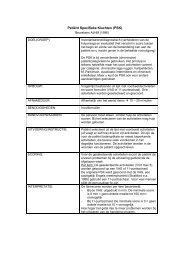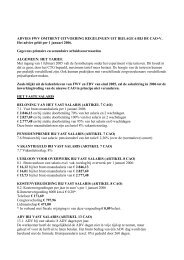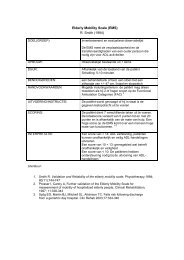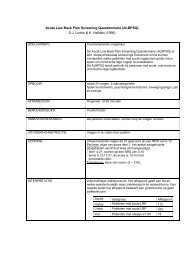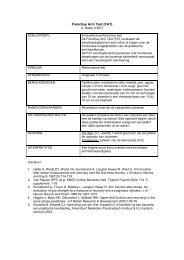Acupuncture and dry-needling for low back pain (Review)
Acupuncture and dry-needling for low back pain (Review)
Acupuncture and dry-needling for low back pain (Review)
You also want an ePaper? Increase the reach of your titles
YUMPU automatically turns print PDFs into web optimized ePapers that Google loves.
Yeung 2003<br />
Methods<br />
Participants<br />
Interventions<br />
Outcomes<br />
-R<strong>and</strong>omized in blocks (method not described). R<strong>and</strong>omization was blinded.<br />
-Outcome assessors blinded.<br />
-Funding: The Hong Kong Development Fund <strong>and</strong> Tung Wah Board Fund<br />
-Setting: Outpatient clinic in a hospital. Hong Kong.<br />
-The aims <strong>and</strong> procedures of the study were explained be<strong>for</strong>e written consent was obtained.<br />
Ethical approval from the Ethics Committee of the Hong Kong Hospital Authority <strong>and</strong> the Human Subject Ethics<br />
Subcommittee of the Hong Kong Polytechnic University was obtained prior to the start of the study.<br />
-Fol<strong>low</strong>-up: 49 of 52 patients r<strong>and</strong>omised (94%)<br />
-Analysis: 2-factor mixed repeated measures ANOVA. Intention-to-treat analysis. Dropping patients <strong>for</strong> reasons other<br />
than the treatment were given baseline values. Dropping patients <strong>for</strong> reasons related to the treatments were given<br />
worst score<br />
52 patients with chronic <strong>low</strong>-<strong>back</strong> <strong>pain</strong> (>6 months) with or without radiation. Age between 18 <strong>and</strong> 75 years<br />
Diagnoses: non-specific <strong>low</strong>-<strong>back</strong> <strong>pain</strong>.<br />
Excluded: 1. Structural de<strong>for</strong>mity (ankylosing spondylitis, scoliosis) 2. Lower limb fracture 3. Tumours 4. Spinal<br />
infection 5. Cauda equina syndrome 6. Pregnancy 7. Spinal cord compression 8. Subjects who were unable to keep the<br />
appointments 9. Receiving acupuncture treatment within the past 6 months 10. Receiving physiotherapy treatment<br />
within the past 3 months<br />
Mean age: 53 years old<br />
Gender: 9 males <strong>and</strong> 43 females<br />
Working status: not described<br />
Previous treatments: tui na, massage, chiropractor, bone setter or corset<br />
1) Electro-acupuncture: 3/week <strong>for</strong> 4 weeks by a physiotherapist certificated in acupuncture. Points were chosen<br />
according to the literature: BL23, BL25, BL40 <strong>and</strong> SP6. <strong>Acupuncture</strong> was applied to the side on which patients<br />
reported <strong>pain</strong>. If the reported <strong>pain</strong> was bilateral, EA was applied to the more <strong>pain</strong>ful side. Sterilised disposable needles,<br />
number 30 (0.3 mm) 40-mm long needles were inserted <strong>and</strong> manipulated until Teh Chi was obtained. Electrical<br />
stimulation on needles at a frequency of 2 Hz <strong>for</strong> 30 minutes. The intensity of the stimulation was set at the level<br />
that the patient could tolerate <strong>and</strong> often with evoked visible muscle contractions. The current had biphasic wave<strong>for</strong>m<br />
to the four selected acupoints in two pairs. In addition, all patients also received exercise therapy, the same as in the<br />
control group.<br />
R<strong>and</strong>omized to this group: 26. Lost to fol<strong>low</strong>-up: 1<br />
2) St<strong>and</strong>ard group exercise program led by the same physiotherapist.<br />
The program consisted of an hourly session each week <strong>for</strong> 4 consecutive weeks, <strong>and</strong> comprised <strong>back</strong> strengthening<br />
<strong>and</strong> stretching exercises<br />
In addition, patients were advised on spinal anatomy <strong>and</strong> body mechanics, <strong>back</strong> care <strong>and</strong> postural correction, lifting<br />
<strong>and</strong> ergonomic advice, <strong>and</strong> behavioural modification, as well as a series of home exercises (15 min/day).<br />
R<strong>and</strong>omized to this group: 26. Lost to fol<strong>low</strong>-up: 2<br />
1) Pain: Numerical rating scale <strong>for</strong> “average” <strong>and</strong> <strong>for</strong> “worst” <strong>pain</strong> intensity during the last week, by asking the patient<br />
to rate perceived level of <strong>pain</strong> on a scale from 0 to 10, where 0 represents no <strong>pain</strong> <strong>and</strong> 10 represents <strong>pain</strong> as bad as it<br />
could be.<br />
2) Disability: The Aberdeen LBP scale (19-item) was used to measure <strong>low</strong>-<strong>back</strong> <strong>pain</strong> disability, because it is the only<br />
LBP-specific functional disability scale validated <strong>for</strong> Chinese subjects. Responses to the questions were summed <strong>and</strong><br />
converted to a score percentage between 0 <strong>and</strong> 100, with 0 representing the least disabled <strong>and</strong> 100 the most severely<br />
disabled<br />
These outcomes were measured immediately after, 1 month <strong>and</strong> 3 months after<br />
Costs: not reported<br />
Complications: no adverse reaction or complication.<br />
<strong>Acupuncture</strong> <strong>and</strong> <strong>dry</strong>-<strong>needling</strong> <strong>for</strong> <strong>low</strong> <strong>back</strong> <strong>pain</strong> (<strong>Review</strong>)<br />
Copyright © 2011 The Cochrane Collaboration. Published by John Wiley & Sons, Ltd.<br />
61



